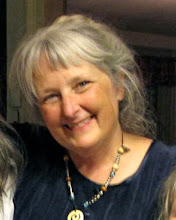Leaf plates and cow dung
It's true that cows wander everywhere in India.

Also goats and pigs in lesser number, but very many dogs. All these animals eat the garbage that people discard, which unfortunately contains increasing amounts of plastic.

People are slowly being educated not to accept plastic bags, cups, or plates, or to throw them away in garbage cans, but in Benares especially, it's a hard change to make. The old system worked so well.
Before the advent of plastic (which is an oil by-product, btw, and therefore an integral part of an oil-based economy), disposable plates in India were made of leaves and tea cups were made of clay. They still are. Cows eat the leaf plates happily, and the clay cups crumble back into the earth or melt back into the river. Since you eat with your fingers, there are no dishes to wash. Traditionally, food is even cooked in disposable clay pots — on a fire of dried cow dung. Cow dung is very good cooking fuel. It burns evenly and as hot or slow as you like, depending on the number of pats you use.
If you take a very early morning walk in India you will see people collecting the cow dung. It is formed into beautiful round patties and laid out to dry in the sun in elegantly patterned piles. The dry pats stack neatly, so a surprisingly large pile can be carried on the head.
Disposable dishes are important in India because of the popularity of pilgrimage. The temples feed so many people.

Prasad, blessed food, is still given out at all the active temples, but often it is a little sweetened milk poured into the palm of your hand, some coconut meat, or some little white balls of sugar. But some temples still prepare full meals in huge quantities for visitors.
Historically, tourism in India was almost always based on pilgrimage. One walked barefoot from temple to temple in a prescribed pattern, camping or staying at guesthouses along the way, and either eating at the temples or buying food from the vendors who line the pilgrimage routes. It is a particular delight to sit on a bench at a tea stall, watching the hot milk boil in a giant bowl-shaped pot on an open fire, drinking some sweet, spicy tea in a clay cup that fits perfectly in your cupped hands.

Today the temples and pilgrimage routes are still crowded though travel by foot is no longer common. The cows wander among the motorcycles, auto-rickshaws, lorries, and cars, and their dung is collected, but big ugly piles of plastic bags and cups line the streets.
The old system worked better.

Also goats and pigs in lesser number, but very many dogs. All these animals eat the garbage that people discard, which unfortunately contains increasing amounts of plastic.

People are slowly being educated not to accept plastic bags, cups, or plates, or to throw them away in garbage cans, but in Benares especially, it's a hard change to make. The old system worked so well.
Before the advent of plastic (which is an oil by-product, btw, and therefore an integral part of an oil-based economy), disposable plates in India were made of leaves and tea cups were made of clay. They still are. Cows eat the leaf plates happily, and the clay cups crumble back into the earth or melt back into the river. Since you eat with your fingers, there are no dishes to wash. Traditionally, food is even cooked in disposable clay pots — on a fire of dried cow dung. Cow dung is very good cooking fuel. It burns evenly and as hot or slow as you like, depending on the number of pats you use.
If you take a very early morning walk in India you will see people collecting the cow dung. It is formed into beautiful round patties and laid out to dry in the sun in elegantly patterned piles. The dry pats stack neatly, so a surprisingly large pile can be carried on the head.
Disposable dishes are important in India because of the popularity of pilgrimage. The temples feed so many people.

Prasad, blessed food, is still given out at all the active temples, but often it is a little sweetened milk poured into the palm of your hand, some coconut meat, or some little white balls of sugar. But some temples still prepare full meals in huge quantities for visitors.
Historically, tourism in India was almost always based on pilgrimage. One walked barefoot from temple to temple in a prescribed pattern, camping or staying at guesthouses along the way, and either eating at the temples or buying food from the vendors who line the pilgrimage routes. It is a particular delight to sit on a bench at a tea stall, watching the hot milk boil in a giant bowl-shaped pot on an open fire, drinking some sweet, spicy tea in a clay cup that fits perfectly in your cupped hands.

Today the temples and pilgrimage routes are still crowded though travel by foot is no longer common. The cows wander among the motorcycles, auto-rickshaws, lorries, and cars, and their dung is collected, but big ugly piles of plastic bags and cups line the streets.
The old system worked better.


0 Comments:
Post a Comment
<< Home